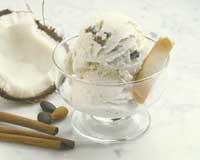How to keep the ice cream always creamy?
2002/06/16 Mendiburu, Joana - Elhuyar Zientziaren Komunikazioa
The salads and ice cream of all the flavors and colors are the menus that you like the most in summer, as in addition to sweets are also refreshing. The consumption of these products increases dramatically, but what to do since last year with the ice cream in the corner of the refrigerator? It is already too hard and granulated.

Professionals have also realized that often ice creams harden too much and lose a fat and creamy structure. And although in winter the consumption of ice cream is reduced, professionals do not usually enjoy winter holidays. In addition to inventing new flavors, they seek solutions to this type of problems. The congresses of these professionals are held during the winter season and in one of them was announced the idea that to avoid the ice cream coming out hard and crystallized, scientists have proposed to use the proteins of the winter wheat.
But since we are not professionals, before immersing ourselves in research, we learn how ice cream is made industrially.
How is ice cream made?
The process of making the ice cream consists of several phases. The first step is to select, weigh and mix raw materials until you get a mix or a ‘mix’. Raw materials are automatically measured and the mixture is mixed at a temperature of 50-70ºC.
Homogenization is achieved by the explosion and dispersion of the fat cells at a pressure of between 150 and 200 kg/cm 2. Thus, the ice cream will be more creamy and its flavor is more evident.
Then pasteriza the mixture to remove all germs (pathogens and non-pathogens). To do this, the mixture is heated to a temperature of 85 °C for a few seconds and suddenly drops to 6ºC.
So ‘clean’ let the mixture stand for four hours at a temperature of 4-6 °C to improve the quality of the final product.
In the freezing phase, the mixture hardens into the refrigerator. At the same time, air is added to the mixture, which gives a more creamy structure. In this way, the initial hard mixture is softened. He gets into the molds and, point, freezes quickly to keep them in good condition until the hot summer days. It is kept until summer at a temperature of -27ºC.
Growing consumption

At the annual meeting of the American Association for Science Development, ice cream science expert Douglas Goff of Canada's Guelph University offered a conference entitled "Ice Cream Science". According to this researcher, "in the last two decades the ice cream industry has evolved a lot and it is very difficult to make rich ice creams industrialized". He says that in home cooking you can make sweet ice cream without knowing anything about the science of ice cream, but the industry asks for other research and techniques.
But despite the loss of quality, it seems that the market continues to grow, both in the United States and in Europe. Each American consumes 24 liters of ice cream per year. Average consumption in European countries is much lower. Sweden is the country that consumes the most ice cream, 12.7 L per person, and Portugal the least, 3.9 L per person.
But consumption is growing and in some European countries, such as France, between 1982 and 1997 has doubled. This increase has been driven by advertising, the demands of children and the consumption of ice cream in various ways. And today, in addition to the cucurucho, in the form of cake, in chocolates filled with ice cream, in numerous accommodations, etc. It is eaten ice cream. It is clear that more attention is paid to advertising than to the advice of dieticians.
More creamy time
How difficult it is not to fall into the temptation of the creamy and sweet texture of ice cream! Ice cream is due to the union of ice cubes, air bubbles and fat molecules. However, as has already been said, the ice cream, after a long time, loses this structure and, in case of finding a solution, it had to identify that union. In this work the researcher Douglas Goff has worked, who has recognized that "it has not been an easy job and that electronic microscopes have been necessary".

Goff studies show the existence of a matrix of very small fatty blood cells surrounding air bubbles and ice crystals. In this sense, he has seen that to avoid the formation of ice cubes, it is possible to use a winter wheat protein. This protein prevents the freezing of wheat seeds in winter. To do this, they stick at the end of the cubit and avoid their growth.
The goal of Goff is to add these proteins to ice cream and make them fulfill their function in nature. Thus, the ice cubes would be very small and the ice cream would always be creamy.
But this intention is not to the liking of all experts. And it is that some prefer a more rigid and uneducated structure. According to them, the true ice cream does not have a sweet and fat structure.
It is time to eat the ice cream. Happy!
Published in 7K.

Gai honi buruzko eduki gehiago
Elhuyarrek garatutako teknologia




